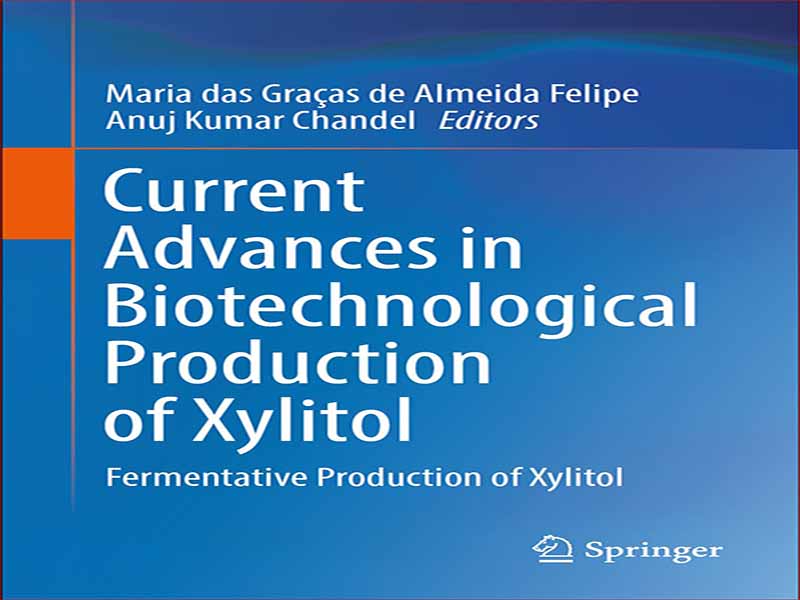- عنوان کتاب: Current Advances in Biotechnological Production of Xylitol
- نویسنده: Maria-das-Graças-de-Almeida-Felipe
- حوزه: بیوتکنولوژی
- سال انتشار: 2022
- تعداد صفحه: 261
- زبان اصلی: انگلیسی
- نوع فایل: pdf
- حجم فایل: 4.89 مگابایت
تبدیل زیستی زیست توده لیگنوسلولزی به سوخت های زیستی و بیوشیمیایی مزایای استراتژیک و زیست محیطی متعددی را ارائه می دهد. یکی از ترکیبات ارزشمندی که می توان از زیست توده لیگنوسلولزی ساخت، زایلیتول است. این یک قند الکل تجاری قابل دوام است که کاربردهای متعددی در بخش های غذایی، قنادی، ادنتولوژی و داروسازی دارد. بر اساس تقاضای رو به رشد برای زایلیتول، وزارت انرژی ایالات متحده (USDOE) زایلیتول را در 12 ماده شیمیایی با ارزش افزوده تولید شده از مواد اولیه لیگنوسلولزی قرار داده است. تولید زایلیتول از هیدرولیز همی سلولز سودآورتر از اتانول یا تولید مشترک اتانول و فورفورال در نظر گرفته می شود. زایلیتول یک پودر کریستالی سفید رنگ، محلول در آب و از نظر طعم مشابه شکر سفره با کالری کمتر است و از جمله خواص ضد پوسیدگی و ضد میکروبی است. علاوه بر استفاده متداول از زایلیتول به عنوان یک شیرین کننده کم کالری، می توان آن را به عنوان یک ماده شیمیایی پلت فرم برای سنتز شیمیایی اسید زایلاریک، اتیلن گلیکول، گلیسرول و غیره در نظر گرفت. بنابراین، در سال های اخیر، تقاضای تجاری برای زایلیتول به طور قابل توجهی افزایش یافته است. در حال حاضر، زایلیتول دارای یک بازار 823.6 میلیون دلاری است که انتظار می رود تا سال 2025 به 1.37 میلیارد دلار افزایش یابد. در حال حاضر، این افزایش تقاضا در سراسر جهان از طریق تبدیل شیمیایی هیدرولیز همی سلولزی تامین می شود. با این حال، سنتز شیمیایی چندین چالش زیست محیطی و پایدار مانند نیازهای شیمیایی بالا، ردپای کربن بالا، مصرف آب بالا و خوردگی راکتور دارد. به منظور جایگزینی دگرگونی های شیمیایی، روش های بیوتکنولوژیکی تولید زایلیتول از مزایای سازگاری با محیط زیست و پایدار بودن برخوردار هستند. آبگوشت تخمیر پس از جداسازی زیست توده می تواند به طور مستقیم برای بازیابی و تغلیظ زایلیتول با حداقل مراحل خالص سازی استفاده شود. محلول غلیظ زایلیتول همچنین می تواند به طور مستقیم در قنادی ها یا در فرمولاسیون خمیردندان استفاده شود و نیازی به کریستالیزاسیون نباشد.
Biotransformation of lignocellulosic biomass into biofuels and biochemicals offers numerous strategic and environmental benefits. One of the valuable compounds which can be made from lignocellulosic biomass is Xylitol. It is a commercially viable sugar alcohol that has several applications in the food, confectionaries, odontological, and pharmaceutical sectors. Based on the growing demand for xylitol, the US Department of Energy (USDOE) has included xylitol in the top 12 valueadded chemicals produced from lignocellulosic feedstock. Xylitol production from the hemicellulose hydrolysate is considered more profitable than ethanol or co-production of ethanol and furfural. Xylitol is a white crystalline powder, soluble in water, and similar in taste to table sugar with a lower calorific content, and it has anticariogenicity and antimicrobial properties, among other properties. Besides the common use of xylitol as a low calorific sweetener, it can be considered as a platform chemical for the chemical synthesis of xylaric acid, ethylene glycol, glycerol, etc. Therefore, in recent years, the commercial demand for xylitol has increased significantly. Currently, xylitol has a market of US$823.6 million which is expected to rise approximately to US$ 1.37 billion by 2025. Currently, this increased demandworldwide is being met through the chemical conversion of hemicellulosic hydrolysate. However, chemical synthesis has several environmental and sustainable challenges like high chemical requirements, high carbon footprints, high water usage, and reactor corrosions. In order to replace the chemical transformations, biotechnological methods of xylitol production have the advantages of being eco-friendly and sustainable.Xylitol production by microbial fermentation offers several unique advantages because it has a very low amount of inhibitors compared to the chemical synthesis. The fermentation broth after separation of biomass can be directly used for xylitol recovery and concentration using minimum steps of purification. The concentrated xylitol solution can also be directly used in the confectionaries or in toothpaste formulations avoiding the requirement of crystallization.
این کتاب را میتوانید از لینک زیر بصورت رایگان دانلود کنید:
Download: Current Advances in Biotechnological Production of Xylitol




































نظرات کاربران